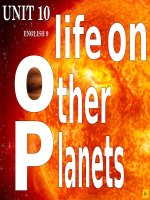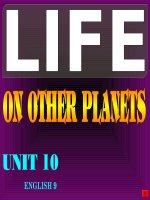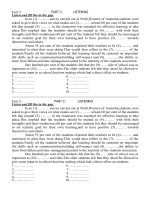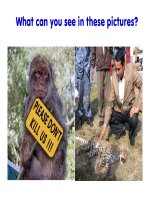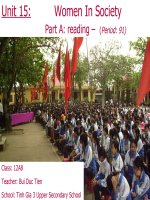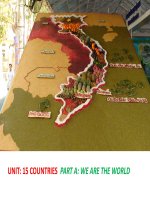Unit 10 - Part A
Bạn đang xem bản rút gọn của tài liệu. Xem và tải ngay bản đầy đủ của tài liệu tại đây (3.96 MB, 28 trang )
Welcome to our class
Teacher: Dang Thi Lan Huong
Rules
•
The class is divided into 2 groups.
•
The groups take turns to choose numbers then
answer some questions.
•
The group giving the wrong answer will lose
your turn. The next group will go on giving
another answer for the current question.
•
If you guess the picture behind numbers, you’ll
get total marks. If your answer is wrong, minus
2 marks.
Good luck!!!
1
3
5
2
4
6
Part A:
READING
Before you read:
One found throughout
Africa and Asia, they
are now only scattered
throughout east Africa.
Cheetahs:
Looking at these pictures and read the information carefully :
Pandas:
It is estimated that only 1,000 pandas remain in the wild.
Siberian Tigers:
There are only about 20
Siberian tigers left in the
wild in China and about
100 live in Chinese zoos
and national parks.
Work in pairs:
cheetahs
Siberian Tigers
pandas
1. What do you understand from the facts
above?
2. Can you expain why the numbers of
these animals have become small?
Question 1:
What do you understand from the facts
above?
The facts about endangered species help us understand
more about the environment:
+ We kwon more about the sharp decrease of the
rare animals in the world.
+ We have to think more about our responsibilities.
+ We love animals, especially rare animals so we
have to protect them.
Answer:
The number of rare animals have become small
because of the people’s interference with the
environment. We kill animals for food, skin, fun…,
we build many cities and villages where forests once
stood, we cut down trees, we destroy the air, we
destroy the environment through our actions.
Answer:
Question 2:
Can you explain why the numbers of
these animals have become small?
While you read:
Vocabulary:
exist (v) /ig'zist/
co-exist (v) /'kouig'zist/
species (n) /'spi: ∫iz/
influence (n) /'influʊəns/
environmemt (n) /in'vɑiərənmənt/
industry (n) /'indəstri/
agriculture (n) /'ægrikʌlt∫ə(r)/
destroy (v) /di'strɔi/
pollutant (n) /pə'lu: tənt/
respect (n) /ri'spekt/
actions (n) /'æk∫n/
habits (n) /'hæbit/
result (n) /ri'zʌlt/
consequence (n) /'kɒnsikwəns/
rare (adj) /reə/
decrease (v) /di'kri: s/
rapidly (adv) /'ræpidli/
extinct (adj) /iks'tiηkt/
disappear (v) /disə'piə/
effort (n) /'efət/
protect (v) /prə'tekt/
endangered (adj) /in'deindʒəd(r)/
establish (v) /i'stæbli∫/
laws (n) /lɔ: /
prohibit (v) /prə'hibit/
survive (n) /sə'vaiv/
offspring (n) /'ɑfsspriη/
Task 1: Fill in each blank with a word above:
1- Dinosaurs became………………millions of years ago.
2- She tried to…………… herself from the wind.
3- This species of bird is……………… in numbers every
year.
4- The chemical……………… from cars and factories
make the air, water and soil dangerously dirty.
5- The blue whale is a(an)………………….species.
6- Because of the………………….of human beings,
many animals have become extinct.
pollutants decreasing protect
interference extinct endangered
extinct
protect
decreasing
pollutants
endangered
interference
+ Adj
+ bare V
+ V-ing
+ N
+ N
+ N
Task 2: Circle A, B, C or D that best sums up each paragraph:
1. Paragraph 1
A. Human beings need to grow food.
B. Human beings pollute the environment
C. Human beings interfere with nature.
D. People should stop living in cities and villages.
2. Paragraph 2
A. Many animals are disappearing.
B. Human beings are responsible for the changes in the environment.
C. People are in danger of becoming extinct.
D. The human race is also an endangered species.
3. Paragraph 3
A. Human beings have made efforts to protect the environment.
B. Scientists have made a long list of endangered species.
C. People should be kept away from animals and plants.
D. Rare animals do not disappear.
4. Paragraph 4
A. The survival of endangered species.
B. The Earth – a happy planet.
C. Conditions for a peaceful co-existence.
D. People’s interference with the environment.
Task 3: Answer the questions:
What are the serious consequences
of the people’s interference with the
invironment?
W
h
a
t
a
r
e
t
h
e
f
o
u
r
w
a
y
s
b
y
w
h
i
c
h
h
u
m
a
n
b
e
i
n
g
s
a
r
e
c
h
a
n
g
i
n
g
t
h
e
w
o
r
l
d
?
W
h
a
t
h
a
s
b
e
e
n
d
o
n
e
t
o
p
r
o
t
e
c
t
t
h
e
e
n
v
i
r
o
n
m
e
n
t
?
Question 1:
What are the four ways by which
human beings are changing the world?
The four ways that human beings are changing the world:
+ They are changing the environment by building cities
and villages where forests once stood.
+ They are affecting the water supply by using water
for industry and agriculture.
+ They are changing weather the air by adding
pollutants to it.
Answer:
Question 2:
What are the serious consequences of the
people’s interference with the environment?
There are two serious consequences:
+ Many kinds of rare animals are killed.
+ The environment where rare animals are living is
badly destroyed.
As a result the number of rare animals are decreasing
rapidly and they are in danger of becoming extinct.
Answer:
Question 3:
What has been done to protect the
environment?
Efforts have been made to protect the environment:
+ Scientists have made lists of endangered species and
suggested ways to save them.
+ Thousands of national parks all over the world have
been established to protect endangered animals.
+ Laws have been introduced to prohibit the killing of
endangered animals and the destruction of the
environments where these rare animals are living.
Answer:
People and Nature
After you read:
Work in groups, and answer the question: What should we do to protect our nature?
SUMMARY
-
Learn by heart all the new words.
-
Answer questions:
“Find out why some animals have
become extinct?”
- Prepare : Part B (Speaking).
Film
What are they doing?
They are killing whales
What are people doing?
They are cutting down trees. Deforestation
Lucky number
Chúc mừng bạn !
